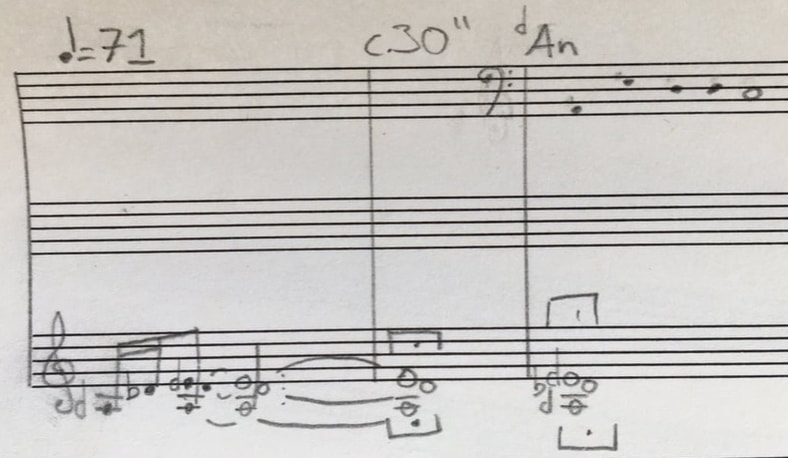My approach to microtonal writing was instinctive rather than systematic. The layout of the piano has shaped my harmonic and melodic writing, from the spacing of chords to the shapes of melodies. Discovering re-tunable synthesisers helped me create unfamiliar key layouts, forcing me into new patterns.
For this disorientation to be successful, a degree of creative ignorance was needed. Which was convenient, given my actual ignorance. I didn’t, initially, study alternate tuning systems but had found myself instinctively reaching outside the twelve-tone palette, initially being confused by chords I could hear but not realise on the piano. Retuning my keyboard began a process of creative unmooring that allowed me to pursue fresh harmonic ideas while maintaining an intuitive relationship with the music. Once I had improvised material that excited me, I would pull back the veil and examine what I had created. I would then develop harmonic procedures based on the needs of the material before me. Below are some brief examples of how I did that: 31-ET, aka “Huygens Fokker’ 31 Equal Temperament was my favourite scale, one that I use in every track other than Flim Flam. It divides the octave into 31 notes. This makes the gap between each note 39 cents, compared to the 100 cents that make up a semitone. When you map this onto a conventional keyboard, the octave is exploded, taking up two octaves and fifth on the keyboard. This is wildly disorienting, making it impossible to play a triad in one hand. Here is how the keyboard looks in this tuning:
Now, there are many things you can do with 31-ET (its crazily extended circle of fifths is very fun, for example). But I was most interested in creating chords and scales that resembled conventional tonality with areas of unaccustomed tension. I particularly love the half minor seventh chord, which comprises two perfect fifths stacked somewhere between a major seventh chord and a minor seventh chord. This chord kicks off the harmonic motion in Flow, where microtonal shifts around that chord dominate the harmonic motion:
In my head, I started to view these chords and intervals as ‘neutral,’ a midpoint between major and minor. This perceived neutrality, or flatness of affect, offered an alternative to more culturally and affectively charged major and minor sonorities. This corresponded with the electronic sounds I was interested in: the dusty, removed sounds of 80s synths as re-imagined by bands like S U R V I V E.
Chants I took this chord based approach in a very different direction in the two Chants on the record. These were inspired by my work with Hildegard’s plainchant that I undertook for Filthy Lucre and which I’m continuing with Sansara. (This is what you'll hear on Saturday.) In this work, I generated microtonal scales at the keyboard and then improvised melodic chants with imagined words within these scales. However, through the work, the scales shift to related microtonal modes. In Chant I, I move from A quarter-flat neutral to F neutral, removing the D quarter flat from the key signature. As you can see from my sketch, I very much viewed these as key signatures, with most notes simply written as 'naturals', and any microtonal 'accidentals' noted with an up or down arrow:
In Chant II, I make a more substantial tonal shift from F sharp neutral to D sharp neutral, a shift that sees the original F and G sharps brought down to quarter sharp. The joy, for me, of this modulation is how gentle it is: the altered notes themselves barely stick out, but the sense of having moved to a new harmonic area is very clear:
These processes have been a creative revelation to me, helping me find a harmonic analogue to the instrumental and electronic sounds I'm interested in. I find it hard to describe these exactly, tending to resort to metaphors: it should sound like rain on a hot day, or fog in a rich landscape. It can also be described well by using the Laban Effort Actions: it is indirect, sustained, and bound, and can be either light or heavy. These are categorised as Flick (when light) and Wring (when heavy).
0 Comments
Leave a Reply. |
NewsYou can find out about recent and upcoming projects here, and stay up-to-date with email or RSS below.
Archives
July 2024
|
|
All photographs by Ilme Vysniauskaite
|





 RSS Feed
RSS Feed